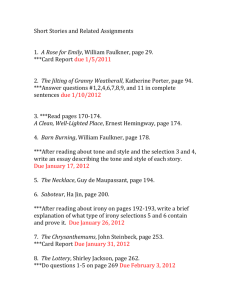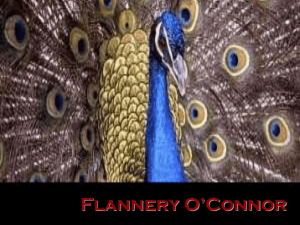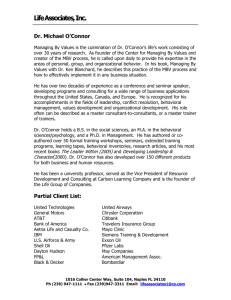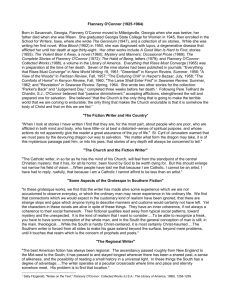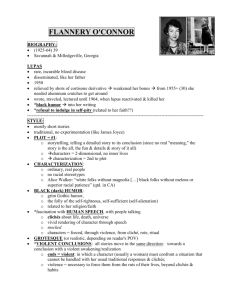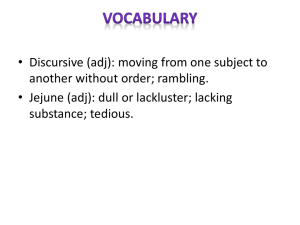Texts Collide When Bakhtin Reads Biblical Allusion in Flannery O
advertisement
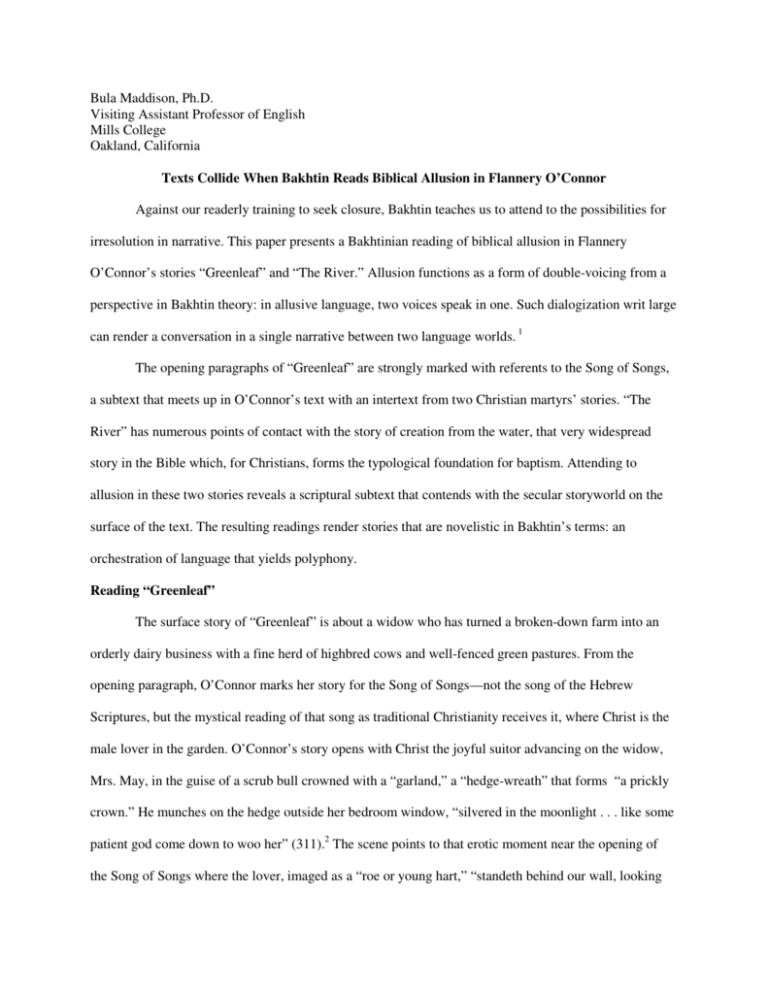
Bula Maddison, Ph.D. Visiting Assistant Professor of English Mills College Oakland, California Texts Collide When Bakhtin Reads Biblical Allusion in Flannery O’Connor Against our readerly training to seek closure, Bakhtin teaches us to attend to the possibilities for irresolution in narrative. This paper presents a Bakhtinian reading of biblical allusion in Flannery O’Connor’s stories “Greenleaf” and “The River.” Allusion functions as a form of double-voicing from a perspective in Bakhtin theory: in allusive language, two voices speak in one. Such dialogization writ large can render a conversation in a single narrative between two language worlds. 1 The opening paragraphs of “Greenleaf” are strongly marked with referents to the Song of Songs, a subtext that meets up in O’Connor’s text with an intertext from two Christian martyrs’ stories. “The River” has numerous points of contact with the story of creation from the water, that very widespread story in the Bible which, for Christians, forms the typological foundation for baptism. Attending to allusion in these two stories reveals a scriptural subtext that contends with the secular storyworld on the surface of the text. The resulting readings render stories that are novelistic in Bakhtin’s terms: an orchestration of language that yields polyphony. Reading “Greenleaf” The surface story of “Greenleaf” is about a widow who has turned a broken-down farm into an orderly dairy business with a fine herd of highbred cows and well-fenced green pastures. From the opening paragraph, O’Connor marks her story for the Song of Songs—not the song of the Hebrew Scriptures, but the mystical reading of that song as traditional Christianity receives it, where Christ is the male lover in the garden. O’Connor’s story opens with Christ the joyful suitor advancing on the widow, Mrs. May, in the guise of a scrub bull crowned with a “garland,” a “hedge-wreath” that forms “a prickly crown.” He munches on the hedge outside her bedroom window, “silvered in the moonlight . . . like some patient god come down to woo her” (311).2 The scene points to that erotic moment near the opening of the Song of Songs where the lover, imaged as a “roe or young hart,” “standeth behind our wall, looking 2 through the windows, looking through the lattices,” those lattices rendered in O’Connor’s story as the slats of a Venetian blind (song 2.9, novel 311, 312).3 The “prickly crown” joins Jesus’ crown of thorns to the song’s lover imaged as “King Solomon in the diadem wherewith his mother crowned him in the day of his espousals” (3.11). “Greenleaf” gives an astonishing form to the pietistic, apologist words prefacing the Song of Songs in the Douay-Rheims Bible in O’Connor’s library: “The Canticle of Canticles is full of high mysteries relating to the happy union of Christ and his spouse: which is here begun by love, and is to be eternal in heaven.” In the traditional Christian reading of the Song of Songs, the erotic love imagery of the garden is sublimated to mystical love. O’Connor restores the eroticism of the lovers’ garden while retaining the identification of Christ as the male lover. With this scrub bull loose on her dairy farm, Mrs. May fears for the purity of her herd. (And was Jesus not famously a spoiler of purity, and, hmm, was there not some question about his paternity?) Fruitlessly Mrs. May directs Mr. Greenleaf, the hired hand, in pursuit of the bull. But under the surface of the action, in language that is highly erotic, the narrator reports the bull in pursuit of Mrs. May. When she is startled, she feels “as if some violent unleashed force had broken out of the ground and was charging toward her” (316). One night in her sleep, she identifies an insistent grinding noise as “the sun trying to burn through the tree line”—here the Son of God imaged as sun, which O’Connor frequently does. At first a “swollen red ball,” the sun begins to “pale and narrow until it looked like a bullet,” which “burst through the tree line and raced down the hill toward her.” When she awakens, she identifies the noise as “the bull munching under her window” (329). The story concludes with that lover meeting his beloved at last in a small pasture that forms a “green arena” (331). The enclosure of the green arena may evoke the song’s invitation “Let my beloved 3 come into his garden” and may join the song also in representing the female body as enclosure: “my sister, my spouse, is a garden enclosed, a fountain sealed up” (5.1, 4.12). Mrs. May sees the bull approaching, “crossing the pasture toward her at a slow gallop, a gay almost rocking gait as if he were overjoyed to find her again” (333). Likewise, the Song’s lover comes “leaping upon the mountains, skipping over the hills” (2.8). Though the lover is “beautiful . . . , sweet and comely as Jerusalem,” he is also “terrible as an army set in array” (6.1, 3). Before Mrs. May can understand what is happening, the bull has “buried his head in her lap, like a wild tormented lover. . . . One of his horns sank until it pierced her heart, and the other curved around her side and held her in an unbreakable grip” (333). The posture mirrors the lovers’ embrace in the Song: “His left hand is under my head, and his right hand shall embrace me” (2.6). The hired hand shoots the bull, and Mrs. May “felt the quake in the huge body as it sank, pulling her forward on its head, so that she seemed . . . to be bent over whispering some last discovery into the animal’s ear” (334). The consummation is made in the story’s closing lines as the two die, locked together. Would Mrs. May’s whisper report the joy of Christ’s bride? There is more than the lovers’ garden beneath the surface story of self-pitying Mrs. May, who martyrs herself to her useless sons and her hired hand. The “green arena,” the topos for the consummation of love in O’Connor’s story, joins the lovers’ garden to the arena where the early Christian martyrs joyously met their deaths as the brides of Christ. O’Connor can be seen to work with imagery from two stories in Acts of the Christian Martyrs, “The Martyrs of Lyons” and “The Martyrdom of Saints Perpetua and Felicitas.”4 5 The martyr stories themselves partake of the garden topos, as can be seen in “the immense garden” Perpetua visits, where sheep are milked (Acts, 111). Saturnus visits “a great open space . . . which seemed to be a garden, with 4 rose bushes and all manner of flowers” (121). Perpetua embraces lost friends “in the garden, under a rose arbour” (123). And, most notably, Perpetua’s story brings the male lover from the garden to the arena: Perpetua has a vision of herself in the Roman amphitheater where, after she has been stripped naked and her body rubbed with oil, she meets a “man of marvelous stature” carrying a green branch of golden apples, who gives her the kiss of peace (Acts, 119). With the subtext of the lovers’ garden and what I would describe as the intertext of the arena, O’Connor eroticizes the mystical story, joining orgasm’s petit mort in the garden to the consummation in death in the arena.6 Meanwhile, the surface text, the modern realist story, insists on the values of the “realist” secular worldview. Mrs. May abhors Mrs. Greenleaf, the wife of the hired hand, who engages in what she calls “prayer healing.” Mrs. May encounters her in the woods one day, wallowing in the dirt, and groaning, “Jesus! Jesus!” “Oh Jesus, stab me in the heart!” (316, 317). Mrs. May winced. She thought the word, Jesus, should be kept inside the church building like other words inside the bedroom. She was a good Christian woman with a large respect for religion, though she did not, of course, believe any of it was true. (316) O’Connor’s ironies are delicious. It is Mrs. May whom Jesus will stab in the heart. Mrs. May, who believes that religion should be kept inside the church, will meet God in an experience that can be described only in those “other words” belonging to the bedroom. And the reader attentive to punctuation will notice the restrictive comma in the phrase “the word, Jesus.” By this comma restricting the meaning of “word” to “Jesus,” Jesus is the Word that “should be kept in the church.” But no, the aroused lover, the scrub bull on the rampage, is made present in this very passage. When Mrs. May first hears Mrs. Greenleaf’s “agonized voice groan[ing] ‘Jesus! Jesus,’” she found the sound to be “so piercing that she felt as if some violent unleashed force . . . was charging toward her” (316). 5 The story in the subtexts reverses the story of the text. It is not uncommon for interpreters to read Mrs. May’s goring by the bull as her comeuppance, the just deserts of her bad attitude.7 Even among interpreters who read the bull as a figure for Jesus, some read the conclusion as his final judgment on Mrs. May. But the under-story renders Mrs. May as the bride of Christ, the beloved of God. As one of my students unforgettably wrote, “Mrs. May is the lost coin or lost sheep or lost son of Luke’s parable, whom God goes to any lengths to find.”8 Reading “The River” In “The River,” a neglected child who needs “fixin” learns from his babysitter who Jesus is, gets baptized at a river healing by a Georgia country preacher, and in the end returns to baptize himself in the river so as to join the Kingdom of Christ. If the story is about baptism, about rebirth to new life, what does it mean that the child drowns in the river? In the Bakhtinian reading I propose, a realist story on the surface of the text reports a tragic death by drowning while the story told in allusion reports rebirth to new life in God. In “Greenleaf,” I showed the workings of two ancient stories, the lovers’ garden and the martyrs’ arena. The beginning of the modern story is marked for one ancient text, the end for the other: the story opens in the lovers’ garden and closes joining that garden to the martyrs’ arena, with the two stories connected and intertwined by an erotic thread running through the narration. The text of “The River” is suffused with biblical story. O’Connor has reset the Christian typological story of baptism as the New Testament reports it: In 1 Peter, “In the days of Noah, during the building of the ark, . . . a few . . . were saved through water. And baptism, which this prefigured, now saves you. . . . ”(3.20-21).9 6 The beginning of the story establishes a standoff in values when a babysitter comes from the countrified outskirts of town to the city apartment of the Ashfields to pick up four- or five-year-old Harry, her charge for the day. The babysitter, Mrs. Connin, thinks poorly of an abstract watercolor she sees on the wall there. “I wouldn’t have paid for that,” she observes, in her uneducated southern vernacular, “I would have drew it my self.” Taking another look as she departs with the child, she lowers her assessment: “I wouldn’t have drew it” (158). The picture on the wall at Mrs. Connin’s house, where she takes the boy, is a picture of Jesus. Reported by the narrator from the child’s perspective, it is of “a man wearing a white sheet. He had long hair and a gold circle around his head and he was sawing on a board while some children stood watching him” (161). When the child inquires about the picture, Mrs. Connin is shocked at his ignorance: he doesn’t know who Jesus is. She reads to him from a treasured old book in her family tradition, “The Life of Jesus Christ for Readers Under Twelve,” “every word of it the gospel truth,” she declares (163). The story in the book, though distorted in the narrator’s report of the child’s reception, is unmistakably the synoptic story of the healing of the Gadarene demoniac (Mk 5.1-20 and parallels). The book has a picture “of the carpenter driving a crowd of pigs out of a man. They were real pigs, gray and sour-looking, and Mrs. Connin said Jesus had driven them all out of this one man” (163). Little Harry has just had a terrifying encounter with a real pig out back of the Connins’, its face “gray, wet and sour,” just like the evil pigs in the book (162). The boy needs no more convincing of the importance of this carpenter. As soon as he gets a chance he sticks the gospel book inside the lining of his coat. The text of the story reports the little boy to be stealing Mrs. Connin’s book. The subtext that begins accumulating here reports the child making Jesus’ story his story when he literally takes the gospel book with him. 7 The biblical story in the subtext begins to swell when Mrs. Connin and her children and little Harry depart to attend a healing at the river. They walked to the river, Mrs. Connin in front with him and the three boys strung out behind and Sarah Mildred, the tall girl, at the end to holler if one of them ran out on the road. They looked like the skeleton of an old boat . . . sailing slowly on the edge of the highway. The white Sunday sun followed at a little distance, climbing fast through a scum of gray cloud . . . (162) With Mrs. Connin’s house already established in the subtext as the place where Jesus’ picture and Jesus’ story can be found—the topos of Jesus’ icon and his Word—the “skeleton of an old boat” recalls the Christian tradition of imaging the church as the ark. That image has its roots in the 1 Peter text cited above, the ark that saved through the water. Here the “scum of gray cloud” corroborates the watery context. The surface text of the healing at the river reports a fundamentalist Christian event, uneducated people gathering near the riverbank, singing, nearby tables laden with food, a few cars and trucks parked along the country road. The young man standing in the water preaches in the cadences of evangelism: “Listen,” he sang. “I read in Mark about an unclean man, I read in Luke about a blind man, I read in John about a dead man! Oh you people hear! The same blood that makes this River red, made that leper clean, made that blind man stare, made that dead man leap! You people with trouble,” he cried, “lay it in that River of Blood, lay it in that River of Pain, and watch it move away toward the Kingdom of Christ.” (165) The subtext joins this yokel to another uncouth preacher in John the Baptist, just in from the wilderness, preaching and baptizing at the Jordan (Mk 1.2-6 and parallels).10 O’Connor’s country boy 8 doesn’t eat locusts and honey, but his appearance whispers of the gospel scene at the Jordan— Now John was clothed in camel’s hair, with a leather belt around his waist. (Mk 1.6, parallel in Mt 3.4) The preacher . . . was a tall youth in khaki trousers . . . . He had . . . a red scarf around his neck . . . (164) —with the intrusion of the red scarf anticipating the bloody neck of John beheaded.11 The Georgia preacher baptizes the little boy. In the surface text, this is a moment of superstitious fundamentalism; in the subtext, the child is reborn as God’s son. In the synoptic scene at the Jordan, Jesus’ baptism culminates with Jesus “coming up out of the water, [seeing] the heavens torn apart and the Spirit descending like a dove,” with the acknowledgement from heaven: “You are my Son, the Beloved; with you I am well pleased” (Mk 1.11b). In O’Connor’s scene, two birds perch “lightly in the top of the highest pine and sat hunch-shouldered as if they were supporting the sky,” and the preacher tells the child, as he comes up gasping from the water, “You count now, . . . you didn’t even count before” (166, 168). Here at the river, we meet Mr. Paradise, a character who greatly resembles the pig that so terrified the child. Mr. Paradise heckles the preacher with secular cynicism: “Pass the hat and give the kid his money. That’s what he’s here for” (166). But allusive language in the subtext renders Mr. Paradise as the Beast of Revelation uttering “blasphemies against God”:12 [Mr. Paradise] had on a gray hat that was turned down over one ear and up over the other to expose a purple bulge on his left temple (166). I saw a beast rising out of the sea . . . . One of its heads seemed to have received a death-blow, but its mortal wound had been healed . . . The whole world followed the beast. They worshiped . . . the beast. . . . The beast was given a mouth uttering haughty and blasphemous words . . . (Rev 13.1-6) 9 When the tired child returns home after his eventful day, his parents and their guests discover the gospel book inside his coat. One of them exclaims, “That’s valuable, . . . That’s a collector’s item,” “I tell you it’s valuable. . . . 1832” (170). This double-voiced ironic language sets the book’s monetary value in the secular world of the text against its spiritual value in the religious world of the subtext.13 The lonely child has learned from the preacher that the muddy red Georgia river is the “rich red river of Jesus’ Blood” is “the River of Faith,” “the River of Life,” “the River of Love”; it leads to the Kingdom of Christ (165). He thinks he knows something about Jesus Christ already; this is the carpenter whose picture he has seen, the fixer, the one who banishes the evil pigs. The next morning when the boy awakens in a dark, cold, and disordered apartment, his parents still sleeping off a hangover, he takes one streetcar token and a Life Saver from his mother’s purse and makes his way back to the river. Mr. Paradise is sitting on the bank, but the boy, focused on his joy at the river, doesn’t see him. He saw only the river . . . and bounded into it with his shoes and his coat on and took a gulp. . . . His coat floated to the surface and surrounded him like a strange gay lily pad and he stood grinning in the sun. He intended not to fool with preachers any more but to Baptize himself and to keep on going this time until he found the Kingdom of Christ in the river. . . (173) The surface text reports a struggle with his own buoyancy: He put his head under the water at once and pushed forward. In a second he began to gasp and sputter and his head reappeared on the surface . . . . The river wouldn’t have him. . . . He thought how far he had come for nothing and he began to hit and splash and kick the filthy river. (173) The subtext offers the baffling scene at the ford of the Jabbok, tributary to the Jordan, where Jacob struggles all night with an unknown, unknowable adversary and emerges as Israel: God’s people is born from the water (Gen 32.24-28).14 10 The boy hears a shout and sees “something like a giant pig bounding after him” (174). On the surface of the text, Mr. Paradise is trying save him, but the subtext reports the Beast in pursuit. When the boy plunges under the water at last, the waiting current caught him like a long gentle hand and pulled him swiftly forward and down. For an instant he was overcome with surprise: then . . . he was moving quickly and knew that he was getting somewhere. . . . (174) The story ends with Mr. Paradise rising “like some ancient water monster . . . , [standing] empty-handed, staring with his dull eyes as far down the river line as he could see” (174). The surface text tells the defeat of Mr. Paradise’s good efforts and implies the death of the child, drowned when the “waiting current caught him like a long gentle hand and pulled him swiftly forward and down.” But the subtext reports the saving hand of God in the current’s “long gentle hand.” According to the surface text, the child, cruelly deceived by his ignorant babysitter and the fanatical preacher, has literalized a symbolic meaning. According to the subtext, in his self-surrender, the child fulfills the story told in the book he appropriated and made his own: the journey through death to everlasting life. As Paul tells it in the letter to the Romans: Do you not know that all of us who have been baptized into Christ Jesus were baptized into his death? Therefore we have been buried with him by baptism into death, so that, just as Christ was raised from the dead by the glory of the Father, so we too might walk in newness of life. (Rom 6.3-4) The language of “The River” is fully hybridized; the story is double-valenced throughout. “He ain’t fixed right,” Mrs. Connin observes of the boy she picks up at the apartment, who has his arm stuck in his coatsleeve. “Well for Christ’s sake, fix him,” Mr. Ashfield responds, speaking in a double voice, his intended meaning reporting the perspective of the text, while the subtext reports the “fix” of salvation. The subtext tells the traditional story of salvation history still going on—from the cosmogony and the 11 Flood, to the journeys of the ancestors, to the promise of the gospels, to the still-menacing beast of the apocalypse. On the surface of the text, the Ashfields and Mr. Paradise represent the modern, secular worldview of the realist story. Here Mrs. Connin is an ignorant woman of the rural South, the preacher a religious fanatic, the story a tragedy reporting the needless death of a child. The values reverse 180 degrees in the subtext. Mrs. Connin’s house and progeny are the saving ark in the life of the church; the Ashfields “live” in the death of dust and ashes. “Mr. Paradise” is the ironic name of the Beast. In the child’s death, he completes the journey to the God from whence he came—exitus et reditus—in the water.15 Poles in the Stories’ Interpretation The critical literature taken in overview can be read to corroborate my readings of “Greenleaf” and “The River” in that the reported readings of both stories tend to cluster around poles of interpretation: either the little boy has committed suicide or he has taken a “transcending leap of faith”; either the story is a “critique of fundamentalist religion” or the current’s “long gentle hand” lifts the child into “a new creation”; either the Reverend Summers is “driven by some twisted theology” or the story rests on “the theology of exitus et reditus—the inexorable procession of all things from God and their equally ineluctable return to him.”16 17 There is substantially less critical literature on “Greenleaf,” but again the affinity for the poles of interpretation can be seen. Either the bull is a lover—whether with “mythical overtones” of Indra, Osiris, Dionysus, and Mithra or of Christ as the medieval unicorn, and Mrs. May’s death is a redemptive end— 12 or, as one reader concludes, “Mrs. May dies . . . shutting herself off from the animating, generative spirit of Jesus on whom Mrs. Greenleaf calls.”18 The standoff in the literature on both stories reflects the standoff I read in the stories themselves. Some critics appear to be reading the modern, secular voice of the text, others the ancient, biblical voice of the subtext. In Bakhtinian language, one might say that the dialogue in the critical literature reports the dialogism achieved the stories. The encounter in the stories between the modern realist text and the scriptural subtext is a form of dialogized heteroglossia: born, Bakhtin said, when distinct language-worlds are brought to “interanimate.”19 In these stories, O’Connor pits one language against another in an unstable weld of world-views that do not mix. The Stories as Parable On the basis of the uneasy weld of conventional, realist story to unconventional, radical Christian story, I follow Sallie McFague in proposing modern parable as O’Connor’s stories’ genre. McFague observes about the Jesus parable: Most of the parables are personal and relational, concerned with ordinary and extraordinary, or conventional and radical, ways of dealing with other people: the Unjust Judge, the Prodigal Son, the Wicked Husbandman, the Great Feast, the Good Samaritan, the Laborers in the Vineyard . . . are stories about absurd, alien, or radical ways of relating to others, given conventional standards.20 From a perspective in Bakhtinian theory, it can be seen that the Jesus parable itself holds two stories together. A subtext of unspoken but expected story underlies the parables’ radical reversal of conventional expectations. Underneath the unconventional values of the Parable of the Prodigal Son is virtue rewarded in the conventional story of family values; underneath the unconventional values in the Laborers in the Vineyard is the conventional economy of labor and wage; underneath the Lost Sheep is 13 the conventional concern for the ninety-nine sheep. Where the gospels assume the conventional story in a subtext and tell the unconventional story in the text, O’Connor reverses the process, with the conventional story now on the surface, the radical story underneath. The subtext now seeks to overturn the surface values of the text: the “martyr” Mrs. May dies a bride of Christ, a drowning child is reborn in the water to God.21 One reader has observed that O’Connor “introduces God’s grace [as a] rupture of this time by the occurrence of apocalyptic time when God intervenes in this world by His presence and revelation.”22 It might also be argued that such an apocalypse participates in the Jesus parable. The time of reversed values when the one lost sheep is valued over the ninety-nine, the time when the fatted calf is killed to welcome the wastrel son, the time when the laborers who worked the least get paid the same as those who worked the most . . . that is the time of the Kingdom Jesus preaches. Theologians differ as to whether the possibility for that Kingdom is now, or not-yet, or now-and-not-yet, but whatever the case, the advent of the Kingdom ruptures time as we know it. The possibility for apocalypse enters the O’Connor stories as well, in the violent moment of intersection between realist text and scriptural subtext: the goring by the bull, the drowning in the river. The “end time” as O’Connor portrays it is not the end of time for all time but rather a means to new beginnings in a breakthrough of the extraordinary that lies latent, always, in the ordinary. She shows something of the surprising nature of those new beginnings in the eroticism of mystical union in “Greenleaf,” and the gay abandonment of self in “The River.” The Possibility for Polyphony To inquire into the possibility for polyphony in the stories is to return to my proposal for Bakhtinian dialogism in the Jesus parable, where conventional and unconventional stories collide. In the 14 parable, as McFague observes, “two standards are in permanent tension.”23 The gospel context of the Jesus parable uses the authority of Jesus, hero of the gospel story, to load the argument in favor of the unconventional on the surface of the text. But the conventional story of the unwritten subtext exerts its force in the powerful hold of the status quo—as readily can be seen in our continuing predilection, after nearly two thousand years, for guarding the ninety-nine sheep. Jesus’ radical message remains a hard sell. John Dominic Crossan characterizes the typical response to the Jesus parable this way: “I don’t know what you mean by that story, but I’m certain I don’t like it.”24 In O’Connor’s modern parables, the source of authority is reversed. Here the secular worldview as reported on the surface of the text has the upper hand. Yet the subtext exerts its force in “Greenleaf’s” motifs of the garden/arena and the watery creation of “The River.” Here the subtext pushes, and for this reader, overtakes or nearly overtakes the stories told in the surface texts. Yet the surface text has a strong hold, as can be seen in O’Connor’s characterization of her reader, very much like Crossan’s characterization of the effect of the Jesus parable: “When I sit down to write,” O’Connor said, “a monstrous reader looms up who sits down beside me and continually mutters, ‘I don’t get it, I don’t see it, I don’t want it.’”25 Bakhtin teaches us to attend, in reading narrative, to the possibilities for tension between languages and language-worlds. I propose that that unreconciled tension can be found in both O’Connor’s modern parable form and its ancient model, the Jesus parable. (And I would add, in passing, that these readings invite a Bakhtinian investigation into the parables of Jesus.) “Greenleaf” and “The River” both can be read to wobble, as secular and sacred worldviews contend in their appeal. In “Greenleaf,” the eroticism in the union of garden and arena motifs, once perceived, is nearly irresistible. Yet scrawny, 15 whining little Mrs. May, ludicrous behind the Venetian blind in her bedtime curlers and coldcream, continues to intrude. In “The River,” the charm of the little boy is very great indeed, and he cannot easily be relinquished to that long and gentle hand in the river. Yet the force of the watery creation cannot be denied: the (re)birth stories—of the cosmos from the Flood, Jacob/Israel, Jesus—insist on their say from beneath the text. O’Connor ends both of these stories ambiguously. When “The River” closes, the reader still must evaluate the figure of Mr. Paradise staring down the river empty-handed: Is the image one of rescue failed or danger averted? “Greenleaf” concludes with conflicting reports: narration from what appears to be an authorial voice reports that as Mrs. May’s body is penetrated by the bull’s horn, “she had the look of a person whose sight has been suddenly restored but who finds the light unbearable” (333). Does this image report her recognition of the divinely delivered “comeuppance” seen by some readers in the critical literature? But the last words of the story, spoken by the narrator from the perspective of Mr. Greenleaf as he rushes toward the scene, report the possibility of intimacy: to him, “she seemed . . . to be bent over whispering some last discovery into the animal’s ear” (334). My own readings lean strongly toward the undertexts but cannot rest there. If this is O’Connor’s procedure—to bury a destabilizing story beneath the surface of her text, thereby making an “assault” on convention—then her method is surely as covert as its outcome is subversive.26 She once advised a friend who was writing a play to “write something with a delayed reaction like those capsules that take an hour to melt in your stomach. In this way, [the play] could be performed on Monday and not make them vomit until Wednesday, by which time they would not be sure who was to blame. This is the principle I operate under and I find it works very well.”27 16 1 Bakhtin himself never takes up the topic of literary allusion. My proposal for allusion as a means of dialogization is developed in Bula Maddison, “The Word in Dialogue: Biblical Allusion and Bakhtin’s Theory of the Novel” (Ph.D. diss., Graduate Theological Union, 2005). 2 Flannery O’Connor, The Complete Stories (New York: Farrar, Straus and Giroux, 1989). Page references are given in parentheses following citations. 3 Biblical citations in this chapter are from Douay-Rheims, the translation in use among American Catholics in the middle part of the twentieth century. Frederick Asals makes the association to the Song of Solomon in this early reference to the lover peeking through the lattice and the closing one (closing of the story) to the posture of the lovers’ embrace, although he reads the last as a “frightening parody” (see below), but not the other allusions noted here: Asals, “The Mythic Dimensions of Flannery O’Connor’s ‘Greenleaf,’” Studies in Short Fiction V 4 (Summer 1968), 320, 327. 4 Herbert Musurillo, ed. and trans., The Acts of the Christian Martyrs (Oxford: Clarendon, 1972), 63-85 and 107-131 respectively. Page references are shown in parentheses. 5 I owe this insight, which is not in the literature, as far as I can see, to my beloved friend and teacher Annette Moran, C.J.S. Her paper “Meditation on Hope: Violence in Flannery O’Connor” is listed but not reproduced in Proceedings of the Annual Convention of the Catholic Theological Society of America, New York City, 1995: Theology and Modern Literature, ed. P. Crowley (New York: Catholic Theological Society of America, 1995). 17 6 I am identifying the martyrs’ stories as intertext because I do not find any clear marker in the text that would signal an allusion as I have defined that device. 7 Ruthann Knechel Johansen, for example, says that “Mrs. May dies . . . shutting herself off from the animating, generative spirit of Jesus”: Johansen, “Flannery O’Connor: The Artist as Trickster,” Flannery O’Connor Bulletin 21 (1992), 123. 8 Luke 15. I thank Jenn Price, Saint Mary’s College, Spring 2000. 9 See also 1 Corinthians: “Our ancestors . . . all passed through the sea, and all were baptized into Moses . . . in the sea” (10.1b-2). 10 Seel and one other make the association between the preacher and John the Baptist: Ibid., 170. 11 A wonderful suggestion made by a student when I made a presentation on “The River” in Barbara Green’s class on Jonah: Graduate Theological Union, November 17, 2003. 12 I thank Asals for the connection to Revelation: Flannery O’Connor: The Imagination of Extremity, 77. 13 Kathleen Feeley, S.S.N.D., also points out this instance and others of language which in her observation has both secular and sacred meanings in Flannery O’Connor: Voice of the Peacock (New Brunswick, N.J.: Rutgers University Press, 1972), 114-135. 18 14 I appear to be alone in making the association to Jacob at the Jabbok. 15 Ralph C. Wood, “The Catholic Faith of Flannery O’Connor’s Protestant Characters: A Critique and Vindication,” Flannery O’Connor Bulletin XIII (Autumn 1984): 21-22. 16 Suicide: Michel Gressett, “The Audacity of Flannery O’Connor,” in Critical Essays on Flannery O’Connor, ed. Melvin J. Friedman and Lewis A. Lawson (Boston: G. K. Hall & Co., 1985), 103. Transcending leap of faith: Gilbert H. Muller, Nightmares and Visions: Flannery O’Connor and the Catholic Grotesque (Athens, Ga.: University of Georgia Press, 1972), 59. Critique of fundamentalism: Ted R. Spivey, Flannery O’Connor: The Woman, the Thinker, the Visionary (Macon, Ga.: Mercer University Press, 1995), 125. New creation: Richard Giannone, Flannery O’Connor and the Mystery of Love (2nd ed., Urbana, Ill.: University of Illinois Press, 1999), 74-75. Twisted theology: Harold C. Gardiner, S.J., in Critical Essays on Flannery O’Connor, ed. Melvin J. Friedman and Beverly Lyon Clark (Boston: G. K. Hall, 185), 191. Exitus et reditus: Ralph C. Wood, “The Catholic Faith of Flannery O’Connor’s Protestant Characters: A Critique and Vindication,” Flannery O’Connor Bulletin XIII (Autumn 1984): 21-22. 17 The few readers who appear to find ambiguity in “The River” conclude that the story is a failure: that it is “theologically puzzling” or that it “fails to convince us that the little boy has done anything but unfortunately confuse a literal meaning and a symbolic meaning.” Respectively, A. R. Coultnard, “Flannery O’Connor’s Deadly Conversions,” Flannery O’Connor Bulletin XIII (1984), 90, and Miles Orvell, Flannery O’Connor: An Introduction (Jackson, Miss.: University Press of Mississippi, 1991), 35. 19 18 Respectively, Frederick Asals, “The Mythic Dimensions of Flannery O’Connor’s ‘Greenleaf,’” Studies in Short Fiction V 4 (Summer 1968), 319; Kristen Meek, “Flannery O’Connor’s ‘Greenleaf’ and the Holy Hunt of the Unicorn,” Flannery O’Connor Bulletin 19 (1990): 31-34; Ruthann Knechel Johansen, “Flannery O’Connor: The Artist as Trickster,” Flannery O’Connor Bulletin 21 (1992): 123. 19 M. M. Bakhtin, The Dialogic Imagination, edited by Michael Holquist, translated by Caryl Emerson and Michael Holquist (Austin: University of Texas Press, 1981), 291. 20 McFague, 49. 21 Some would observe that the parables mentioned—and the genre as it is perceived by McFague and John Dominic Crossan (see below)—are a subset or a subgenre in the Jesus parables. And not all readers would read these parables in this way. For two rather different interpretive approaches, see, for example, Luise Schottroff, The Parables of Jesus (Minneapolis: Fortress, 2006), and William R Herzog, Parables as Subversive Speech: Jesus as Pedagogue of the Oppressed (Louisville: John Knox, 1994). 22 Joseph K. Davis, “Time and the Demonic in William Faulkner and Flannery O’Connor,” Studies in the Literary Imagination 20.2 (1987): 142-143. 23 McFague, 50. 20 24 John Dominic Crossan, The Dark Interval (Sonoma, Calif.: Polebridge, 1988), 39. 25 Quoted in McFague, 64. 26 “Assault” is McFague’s word, 50. 27 Letter to John Hawkes, 13 September 59. Flannery O’Connor, Habit of Being: Letters of Flannery O’Connor, ed., Sally Fitzgerald (New York: Farrar Straus Giroux, 1979), 349.
